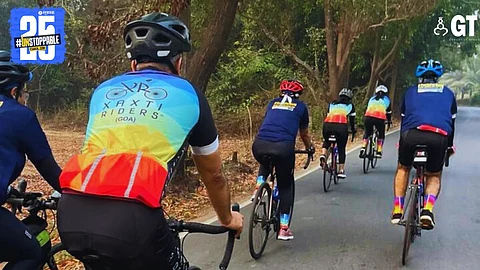

Just a day after the world came together to celebrate the joys and benefits of cycling on World Bicycle Day (June 3), the harsh realities faced by Goa’s two-wheeled community remain far from being resolved.
Among those who celebrated the occasion is veteran cyclist Savia Veigas, who, along with her husband Anoop Babani, once loved pedalling through the picturesque villages of Goa. But over the past year, she’s had to make the painful decision to stop cycling after an accident left her with not just physical scars, but mental ones too.
A REAL CONCERN FOR ALL
“I do feel a sense of loss and regret for not cycling anymore, but the conditions are so hazardous to individual safety that I had to take a call— to stay alive or risk dying on the road,” says Savia.
Savia’s story isn’t an isolated one. Many cyclists across Goa echo the same concerns and fears. Though World Bicycle Day sparked conversations around sustainable mobility and healthy living, the cycling community here continues to pedal uphill against familiar challenges: poor infrastructure, potholed roads, and the ever-present threat of stray animals, all of which make riding feel more risky than rewarding.
Road safety for cyclists is very fragile. The main issue is the unruly and rash car driving and two-wheeler riding, both by locals and tourists.
Anoop Babani, cyclist
THE PRESENT DANGER
Due to speeding and reckless driving, Goa has acquired the dubious distinction of having the largest number of road deaths per capita in the country.
Says Anoop, “Road safety for cyclists is very fragile. The main issue is the unruly and rash car driving and two-wheeler riding, both by locals and tourists. Roads are good but that encourages speeding which is a challenge for cyclists.”
AWARENESS FOR CYCLISTS' SAFETY
Malcolm Coelho, President of Xaxti Riders, says he truly began to appreciate Goa’s beauty only after discovering cycling as a passion and hobby. But he believes change is long overdue when it comes to road safety.
“There needs to be greater awareness among motorbike riders, car owners, and other vehicle users just like you see abroad,” he says. “There should be a dedicated clause that protects cyclists and gives them the right of way, recognising how vulnerable they are on the road. That alone could solve 70 percent of the problem.”
CLEANER ROADS
While the new, broader roads are a welcome development, Malcolm points out a critical issue that often gets overlooked. “All the dirt and debris get pushed to the side, making it difficult, and sometimes dangerous, for cyclists,” he explains.
“In Mumbai, they use trucks equipped with vacuums to regularly sweep the roadside. This keeps the edges clean, allowing cyclists to ride safely along the side without obstructing main traffic. Goa could benefit from a similar system.”
PROPER TRAINING NEEDED
Belinda Viegas Mueller, a MD Psychiatrist and accomplished cyclist who completed the 1,200 km BRM (Brevets de Randonneurs Mondiaux) three times in a single year — earning a place in the Limca Book of Records for this unsupported endurance ride completed within 90 hours (including sleep, meals, and rest) — believes that driving schools must enforce much stricter rules for obtaining a licence.
Goa, I’ve often seen car drivers signal right but hesitate to move into the middle of the lane where they should wait. Instead, they veer left to squeeze past cyclists. Some drivers, spotting a pothole, abruptly swerve right or left without checking, which can be dangerous.
Belinda Viegas Mueller, cyclist
CARS, THE DANGER
She emphasises, “Proper training is essential to make drivers aware that they must maintain a safe distance from cyclists — at least 1.5 meters. In Goa, I’ve often seen car drivers signal right but hesitate to move into the middle of the lane where they should wait. Instead, they veer left to squeeze past cyclists. Some drivers, spotting a pothole, abruptly swerve right or left without checking, which can be dangerous.”
However, she notes a positive exception, “Interstate truck drivers have been the most respectful on the road in my experience, consistently maintaining a safe distance from cyclists.”
TOURISM POTENTIAL?
With its lush greenery and picturesque villages, Goa offers an ideal backdrop to foster a vibrant cycling culture, say local cyclists.
“Cycling tourism holds immense potential here, with Goa’s long winding roads, verdant fields, rolling hills, and stunning ocean views,” explains Anoop. “It truly is a paradise for cyclists—but to fully realize this potential, we must improve infrastructure and prioritize rider safety.”